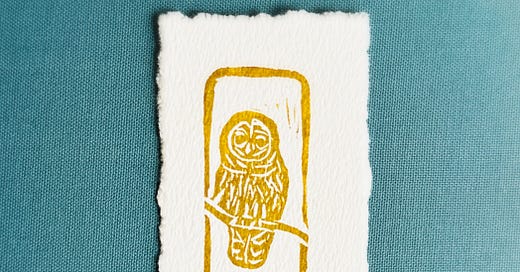
“When the macro is chaos, may there be some solace, even joy, in the micro.” —poet Maggie Smith
Early on in the pandemic, I carved out a corner of our guest room to set up what we all thought would be a temporary little home office. Five years later, aside from accumulating a few more piles of papers and art supplies, the set-up has remained pretty much the same. On the functional side, this was the only spot left in the house with a door I could close for Zoom calls and concentrated editing time.
As it turns out, the space’s true benefit is having windows on three sides and a view of our backyard — a fact that became especially evident when, sometime during those first few months of that first lockdown, a Barred Owl began regularly sitting on one particular pine branch just above eye level, easily visible from my office window.
Perhaps the owl had been perching on this branch for years, and I only saw him1 once I began regularly sitting at my new perch. But there’s a needy human part of me that likes to think he noticed me here in my glass house and thought I could use some company outside my immediate family.
For the decade-plus we’ve lived in this house, we’ve been able to hear Barred Owls calling to each other in the neighborhood.2 Given the frequency and volume, I always suspected one of these hooters lived in our yard. But owls are notoriously stealthy and usually difficult to spot, so it was quite some time before our first glimpse. There was even one especially thrilling year when a gang of 4 or 5 adolescents were hanging out between the corner of our garage roof and a redbud next to the picnic table — a sure sign (at least to my wishful brain) that we had a mating pair nesting in one of our big old white pines.
These fledglings seemed equally wary of and curious about us (definitely not as concerned with staying hidden as their parents), and my son and I were able to walk very slowly out into the yard to have a look from maybe 10 feet away.3 But regular sightings were unheard of until those otherwise uncertain days in the summer of 2020.
Over the years since, there have been periods when he’s there on his branch every day for weeks, and others when I don’t see him for months.

In the great self-centeredness of humans, I now think of this owl as “mine,” when it comes to sit, rather more visibly than I think most owls would do. In the daytime. On a branch just outside my upstairs window. In the same way, I’m bereft and can’t help but take the blame when he disappears again, having, I imagine, gotten quite sick of me looking at him — even when I try to do my gazing on the sly — or completely fed up when I dare take a photo. I mean, how would you feel if you opened your eyes from a nap and some creeper was aiming a lens at you?
In reality, the owl probably gives me very little thought as he rests there on what is his branch more than my tree. And yet, I do feel honored when he comes to sit. When he allows me to steal glances or occasionally stare for a while, I still fizz with excitement every single time.
He’s on that branch right now, as I type, and I’m trying not to disturb his meditation. When he visited last, at the end of January, he only let me look for a short bit before flying off, and I’d always rather he stay.
This little space of my own, this room with a door and window, has become a refuge. I still do my day job here part of the time, but it’s also where I come to focus on my own projects. Where I shuffle in with an early morning cup of coffee for silent writing meet-ups. Where I catch up on reading things that don’t fit into the 9-to-5 but pull me into a curiosity rabbit hole. And when that stripe-breasted beauty is sitting on a branch with his face turned toward me, I feel my place here has been acknowledged, that maybe he’s checking in to see if I’m keeping at it, if I’m paying attention.
I wrote a little haiku for him that January morning, though my dad-joking husband says I should call it a “hai-hoo” instead.
Owl on winter branch
Lifts his brow to my window —
Watching me watch him.
Happy almost-weekend.
PS: I captured a little snippet of our owl in convo with another somewhere in the neighborhood (you might need to crank up the volume to hear it well):
I don’t know why I think of him as a him, except that Barred Owls tend to assign nest duties along sex lines and the females sit on the eggs while the males hunt and bring home food, so I’d guess a male would have more freedom to sit on a branch during mating season at least.
The Audubon Society’s online bird guide includes recordings of the varied calls of Barred Owls. We hear a lot of the “Pair Hootin-it-up” version in our yard — and it is, well, a hoot.
How long baby owls stay with their parents varies widely by species. Barred Owls have a very short rearing span of only six weeks, so we didn’t see those fledglings again after that unusual gathering.
For lots of great info on owls, check out Jennifer Ackerman’s 2023 book, What an Owl Knows.





Oma, I’m going to guess you’ll get some requests for owl prints. 🥹 Just gorgeous.
Fizz. Love that word choice.